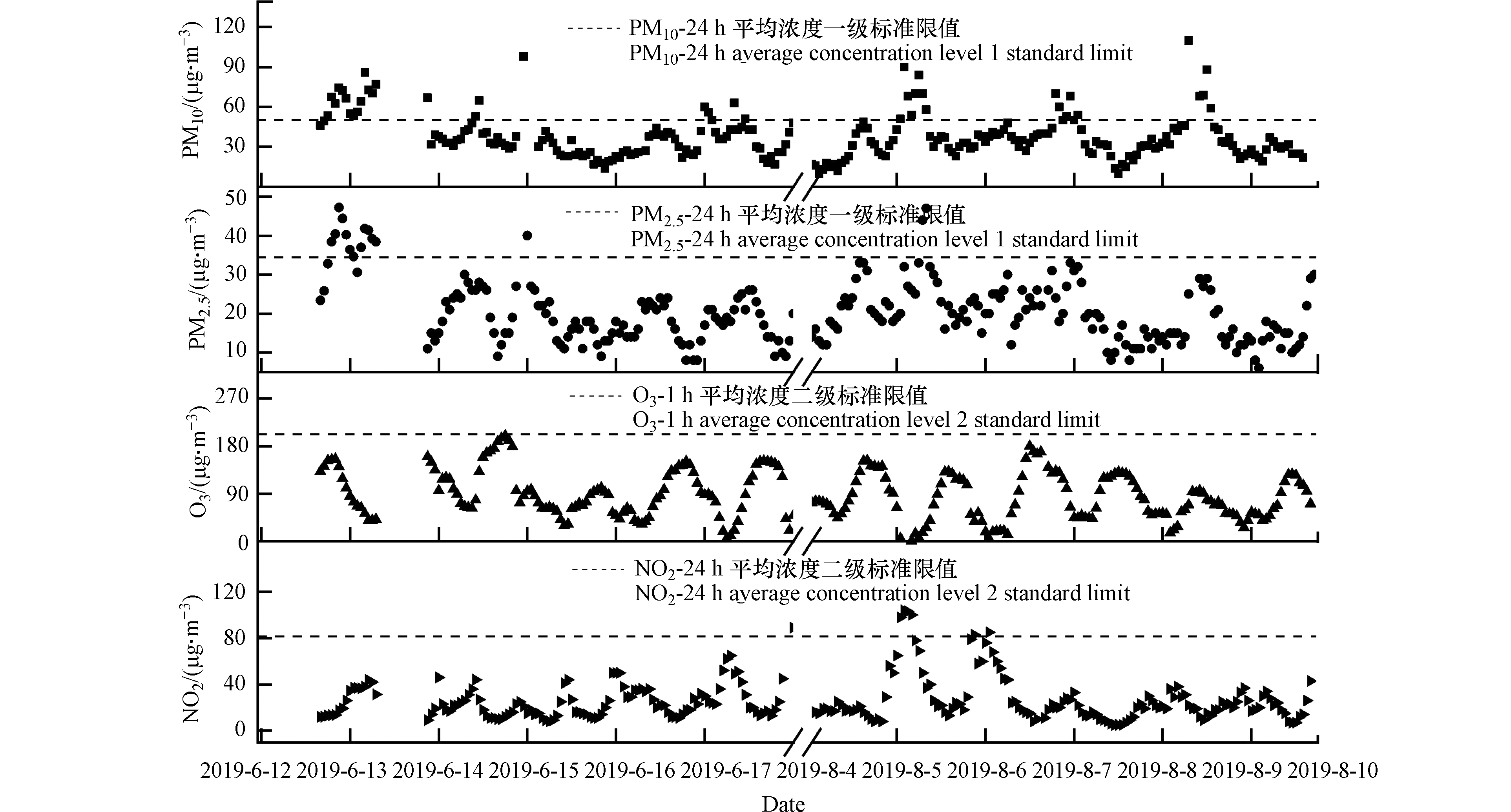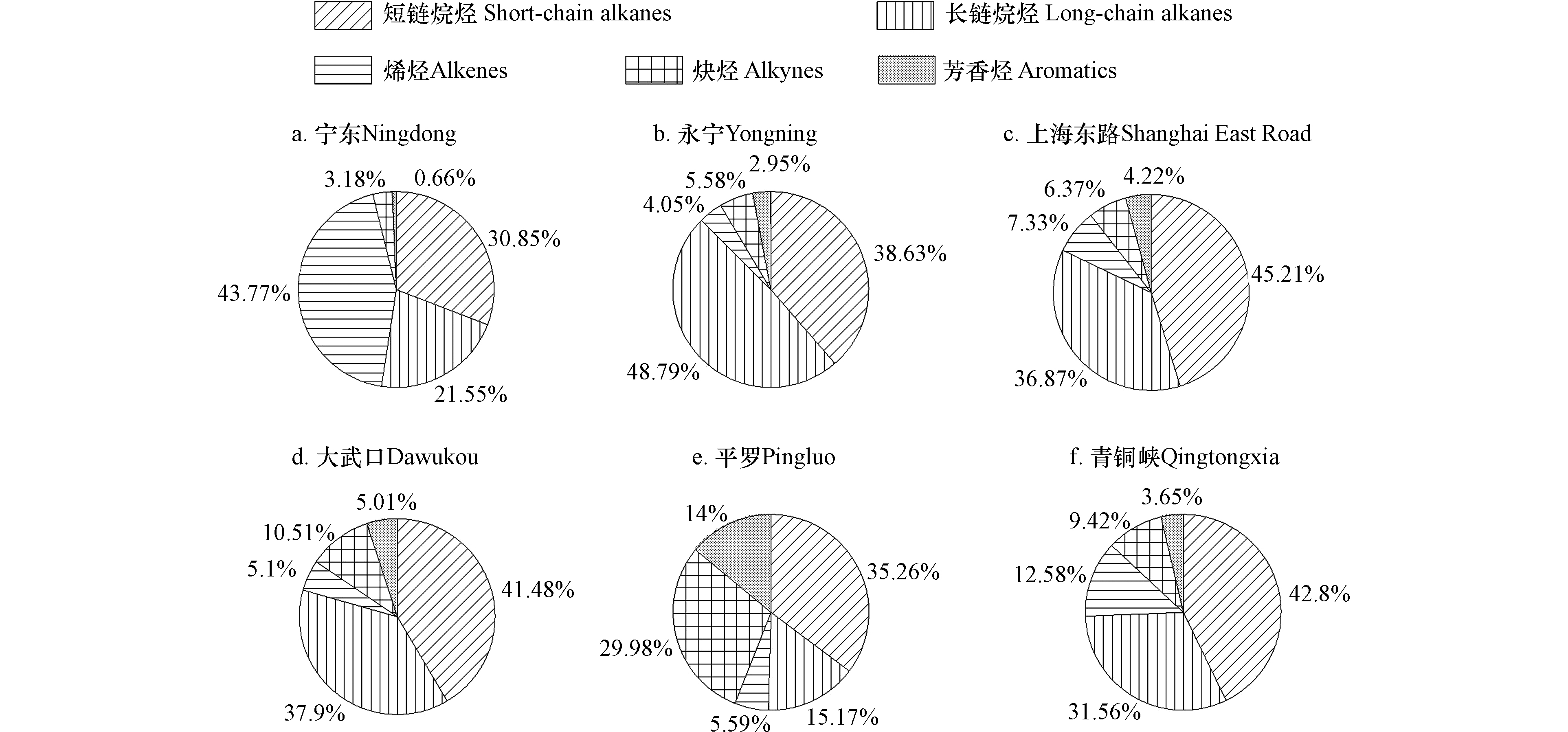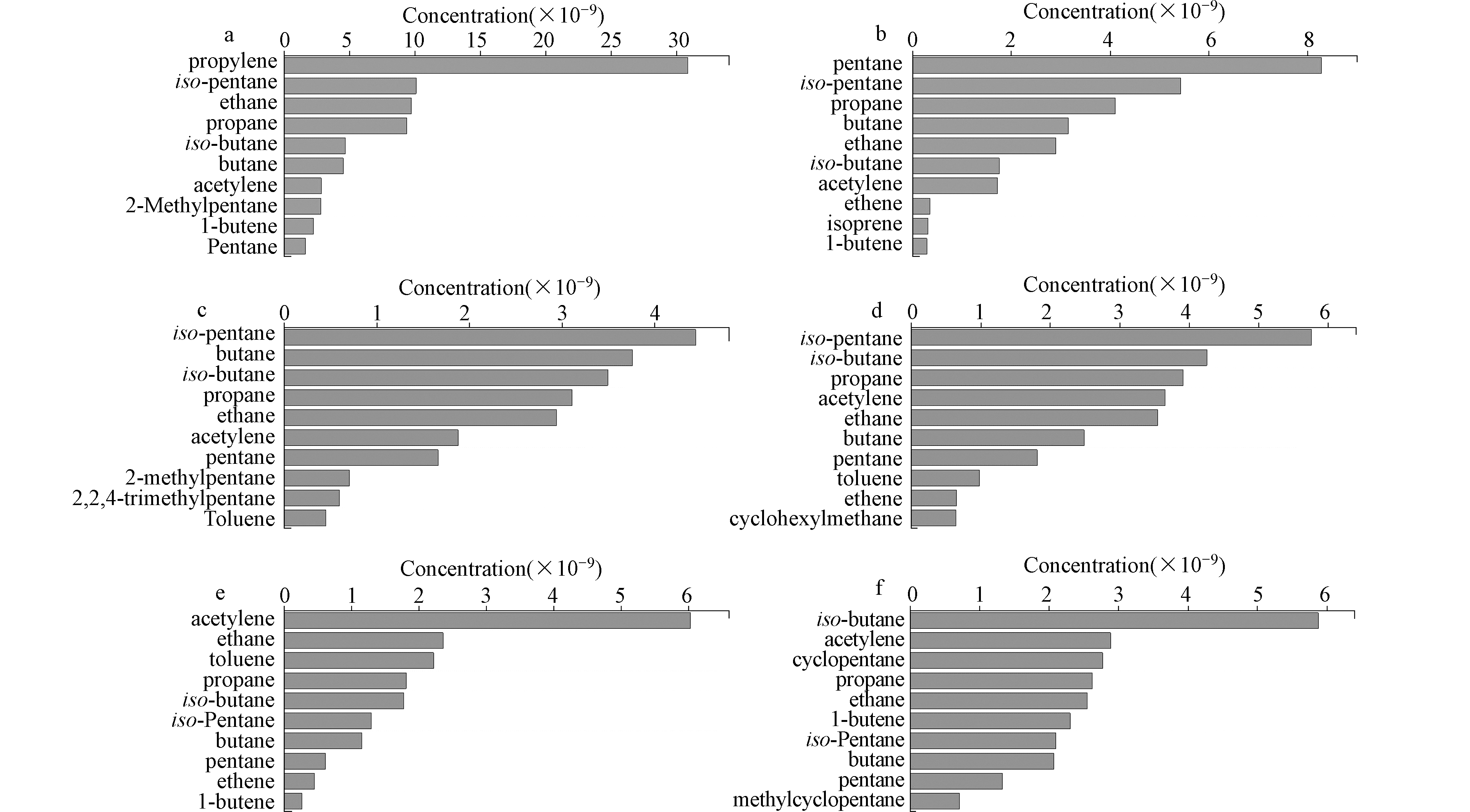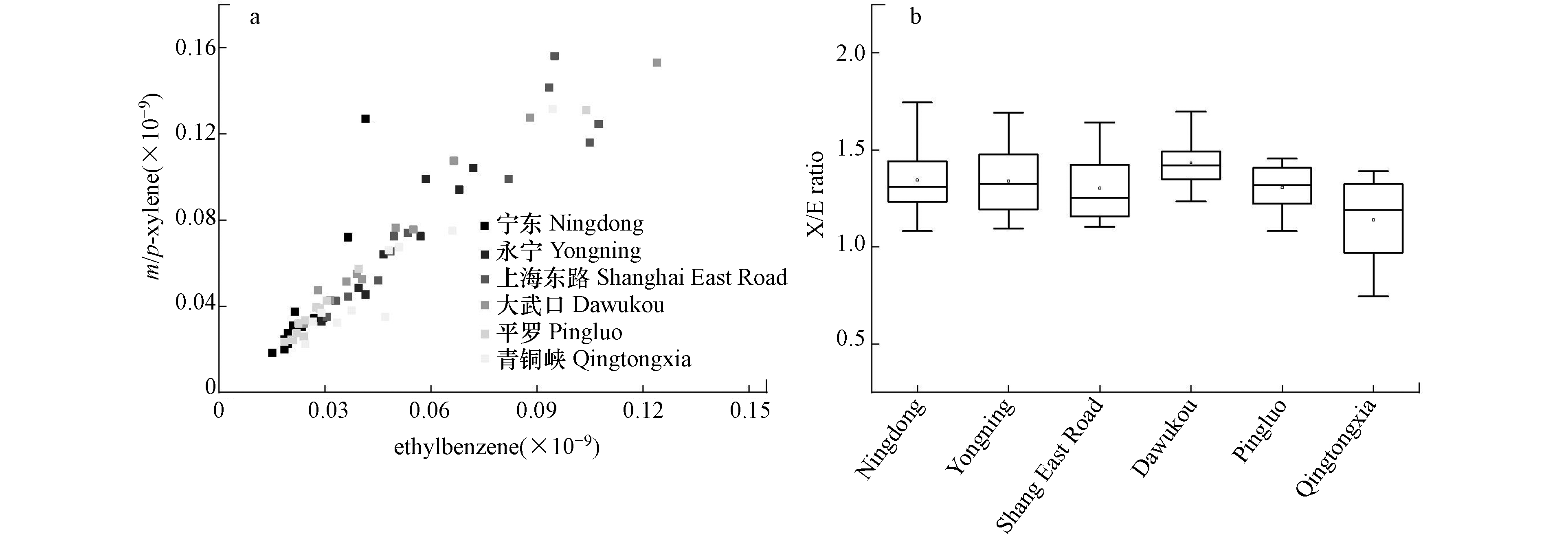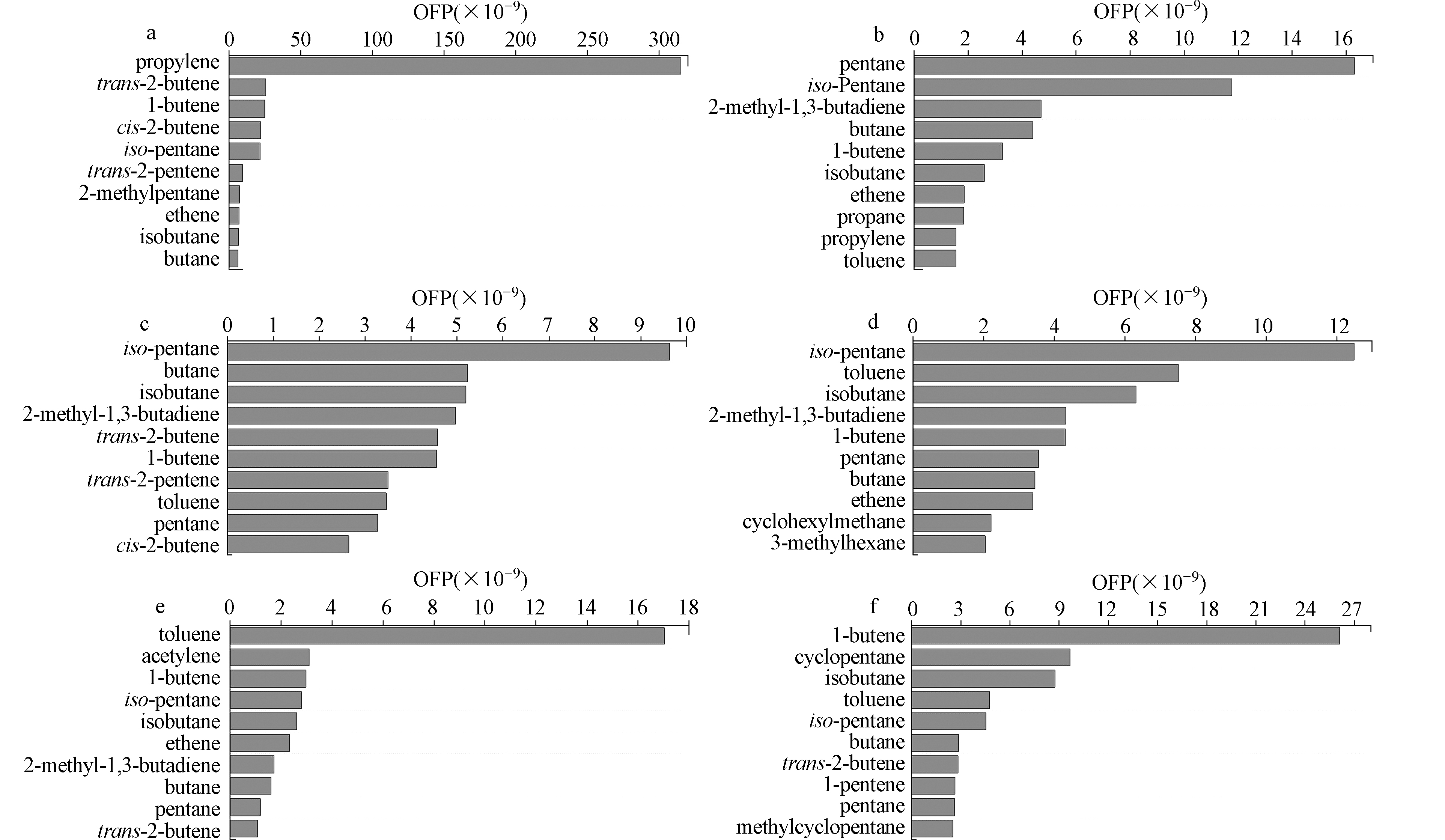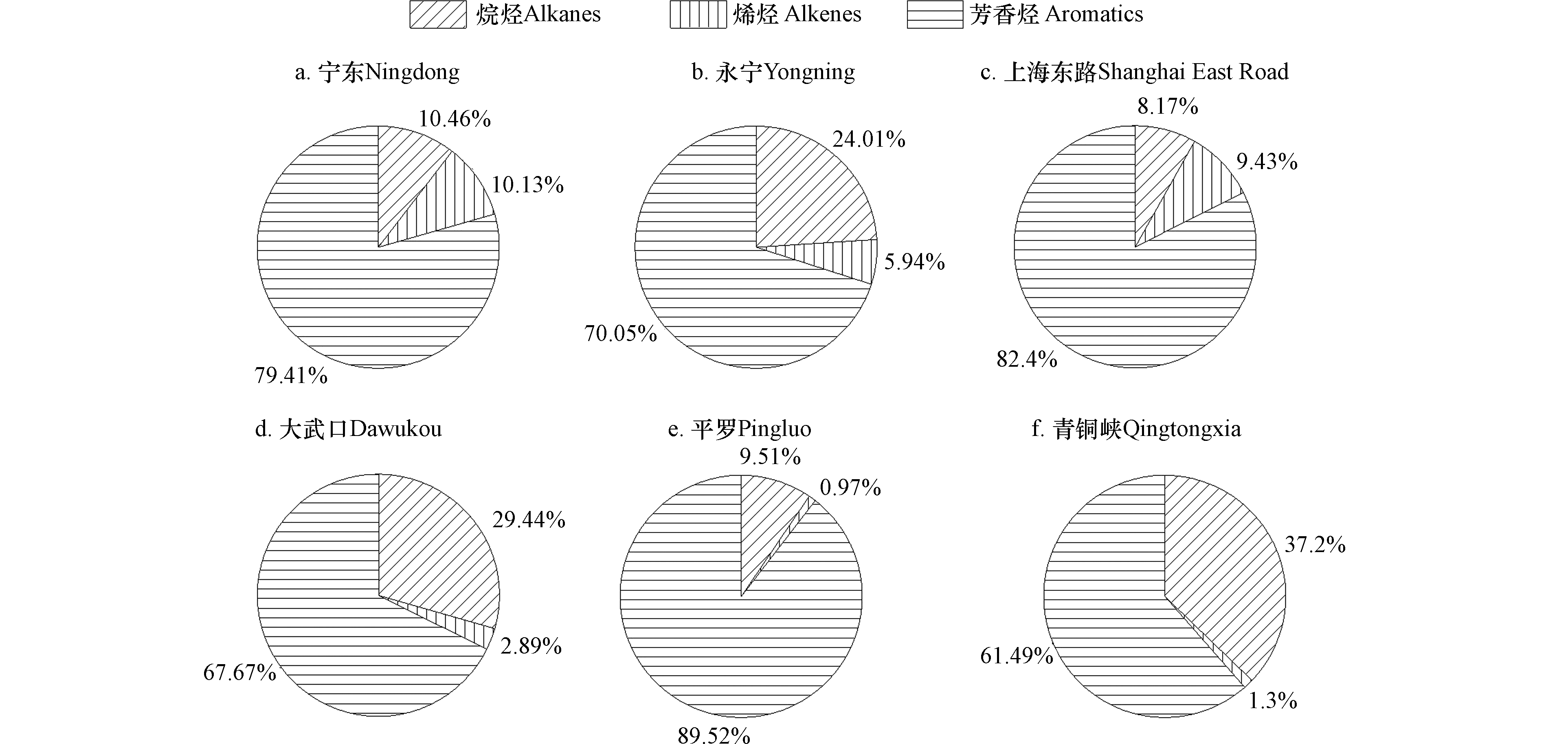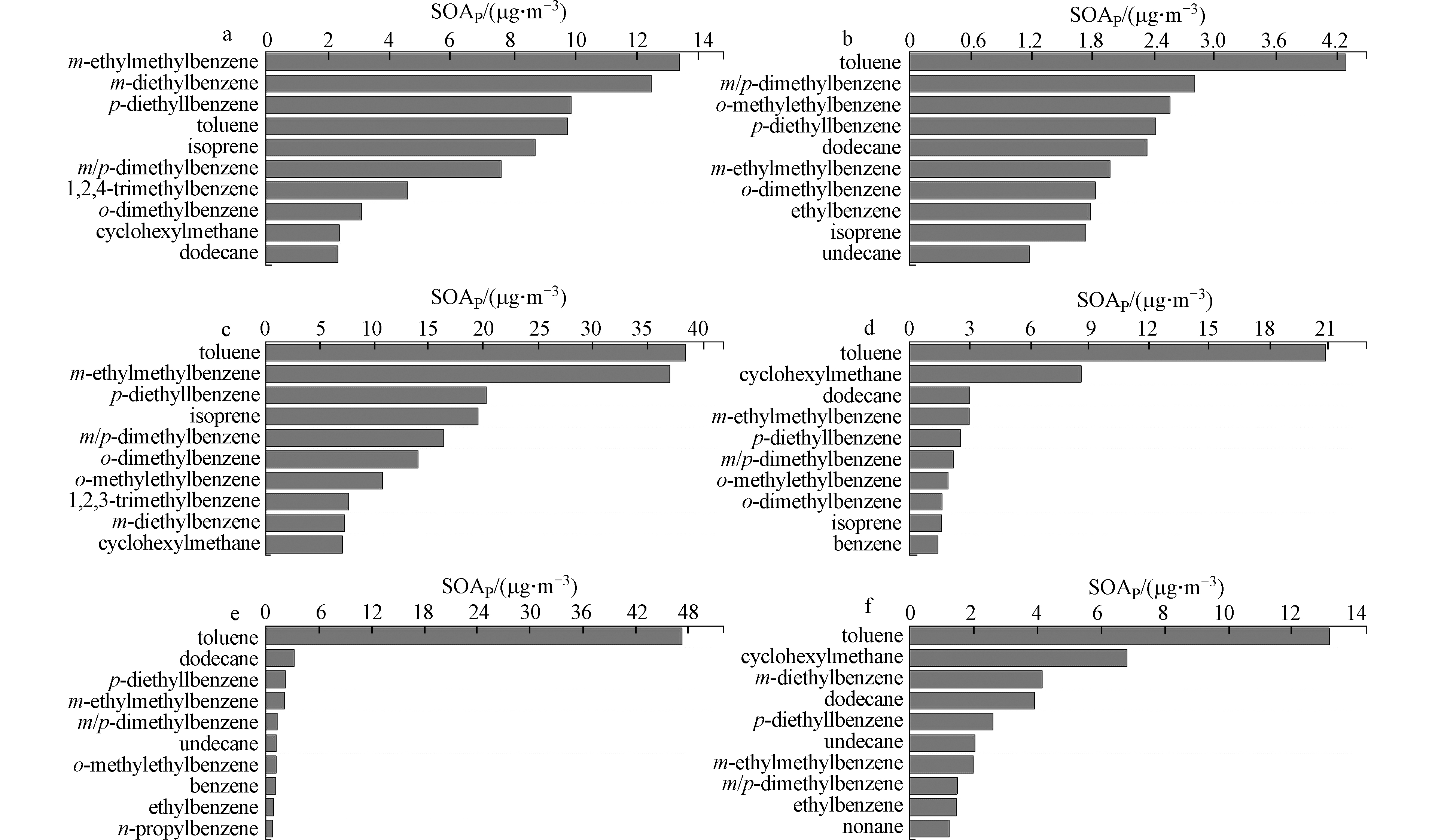-
近年来,我国城市近地面大气臭氧(ozone,O3)污染形势严峻,尤其是在夏季,臭氧已成为导致部分城市空气质量超标的首要污染因子。挥发性有机物(volatile organic compounds,VOCs)和氮氧化物(nitrogen oxides,NOx)的光化学反应是对流层臭氧的主要来源[1-2]。NOx主要来自于发电厂、燃煤锅炉、机动车等排放过程,经过严格治理,近年来全国的NOx 污染状况明显转好,据2015—2019年《中国生态环境状况公报》报道,全国337个城市NO2超标天数比例从2015的1.6%降至2019年的0.6%,但是臭氧污染问题仍然突出,2019年全国337个城市O3-8 h年均浓度为148 μg·m−3,较2015年上升10.45%[3]。VOCs作为臭氧和二次有机气溶胶(secondary organic aerosol,SOA)生成的重要前体物被广泛关注。VOCs来源十分广泛,主要分为天然源和人为源两大类。天然源主要有植物排放,人为源主要有燃料燃烧、溶剂使用、机动车尾气排放、汽油等液体燃料挥发、工业排放等[4]。VOCs成分复杂,包含数百种组分,每种组分具有不同的光化学反应活性,因此,研究挥发性有机物污染特征及其光化学反应特性对臭氧和雾霾污染治理具有十分重要的指导意义。
目前,挥发性有机物的研究主要集中在珠三角、长三角、京津冀等经济高速发展的地区,而西部地区的相关研究相对较少。宁夏回族自治区因其具有丰富的煤炭等资源,成为西部大开发中的重要发展对象,西部大开发以来,宁夏的工业化进程不断加快,能源、新型煤化工、新材料等产业发展迅速,与此同时,光化学污染问题在宁夏日益突出,2015—2019年《宁夏生态环境公报》显示,2019年全区五地市PM10、PM2.5年均浓度较2015年分别下降了24.53%、31.91%,而2019年O3-8 h年均浓度较2015年上升了5.19%(142 μg·m−3),可见,O3正成为宁夏的主要大气污染物之一[5]。为建立协同联动的发展机制,宁夏回族自治区预计2022年前打造完成以银川为核心、辐射带动石嘴山、吴忠、宁东基地协同发展的银川都市圈,银川都市圈的臭氧污染成为大气污染治理的重要对象。
本研究在银川都市圈内6个典型站点开展了挥发性有机物的观测,分析了采样期间挥发性有机物的污染特征、臭氧生成潜势、二次有机气溶胶生成潜势及VOCs潜在来源等,以期为银川都市圈臭氧和雾霾污染治理提供理论依据。
-
本研究于2019年6月12日—17日、8月4日—9日在银川都市圈内对环境空气中挥发性有机物进行了观测。采样点分别位于银川都市圈内的灵武市、永宁县、银川市、大武口区、平罗县和青铜峡市(图1),涉及工业区、商业/交通/居民混合区和工业/交通混合区(表1)。宁东和永宁采样点位于工业区,大气污染源复杂。宁东采样点位于宁东煤化工基地的某烯烃公司内,周围分布有煤制油、煤制烯烃、煤制乙二醇及精细化加工等化工企业。永宁采样点位于望远镇工业园的某药业公司内,周围集聚有家具厂、彩钢厂等工厂。上海东路和大武口采样点位于商业/交通/居民混合区,两个采样点周边都集中有居民区和商场,人口密度及交通流量较大。平罗和青铜峡采样点位于工业/交通混合区,二者周围均分布有高速公路及少数工厂,平罗采样点位于某精细化工有限公司内,青铜峡采样点位于新材料基地内。样品采集按照美国国家环境保护局(USEPA)推荐的标准方法(TO-14A[6]和 TO-15[7]),利用苏玛罐采集环境空气样品。采样前用自动清罐仪(Entech 3100;Entech Instrument Inc,California, USA)对苏玛罐进行清洗,采样频率为全天24 h,采样高度距地面1.5 m左右。表2给出了观测期间2019年6、8月份各采样点温度、湿度和主导风向的统计结果,6、8月份的平均温度分别为26.6℃、28.8℃,平均湿度分别为37.9%、40.7%,各采样点6月份主导风向以东南风、西北风和西北转北风为主,8月份以西北风为主。除少数几天有阵雨外,观测期间各采样点多为晴朗或多云天气。
-
本研究使用搭载微板流控技术(Dean-Switch)的GC-MS/FID分析样品[8]。环境空气样品通过预浓缩仪(Entech7200;Entech Instrument Inc, California, USA)进行富集浓缩。样品依次进入三级冷阱的M1、M2、M3模块,目标化合物在此过程中被富集浓缩,同时,水和二氧化碳也被去除[9]。浓缩后的样品被载气带入气相色谱系统(Trace 1300; Thermo fisher, USA)进行分离和检测。气相色谱内选用 TG-1MS 和 TG-BOND Alumina(Na2SO4)色谱柱分别对高碳(C6—C12)VOCs和低碳的(C2—C6)VOCs进行一级和二级分离,随后低碳组分(乙烷、乙烯、丙烷、丙烯和乙炔)载入FID检测并用外标法定量,高碳组分(碳数较高的烷烃、烯烃和芳香烃)载入MS检测并用内标法定量。本研究选取在光化学反应中活性较高的56种挥发性有机物(PAMS组分)为目标化合物。
-
本研究使用PAMS标准气体购自美国Linde Electronics and Specialty Gases公司。本方法按照5个浓度水平的混合标准气体(不含0点)建立标准曲线,标准曲线线性回归的决定系数R2均大于99.99%,所有目标化合物具有良好的重现性(相对标准偏差均小于10%)。利用信噪比 S/N=10为方法检出限,目标化合物的检出限范围为7
× 10−12—24× 10−12(体积分数)。每批样品设置实验室空白和采样空白以减少误差,此外,定期对分离柱进行老化,并对仪器进行单点校准和峰窗漂移校准。 -
观测期间银川上海东路环境空气中PM10、PM2.5、O3、NO2浓度水平见图2。O3和NO2的浓度分别为(5.0—200.0)μg·m−3和(5.0—123.0)μg·m−3,O3的浓度呈现出昼高夜低的日变化特征,其峰值出现在15:00—18:00;而NO2在日间浓度较低,呈现出与O3相反的日变化趋势,这可能是随着日出后光照强度的增加,前夜积累在对流层的NO2发生光解,O3浓度开始升高,并在后续的光化学过程发展中达到峰值,随着光照强度减弱,由NO2光解生成O3的速率逐渐降低,O3与NO的反应导致O3浓度逐渐下降,NO2浓度在前半夜的升高。此外,夜间NO2浓度还可能与较低的混合层高度有关,NO2在低层大气中积累,随着日出后边界层的抬升,NO2等人为排放污染物的浓度得到稀释。观测期间,PM10和PM2.5的浓度分别为(10.0—110.0)μg·m−3和(6.0—47.2)μg·m−3,根据环保部《环境空气质量标准》(GB3095—2012),PM10和PM2.5的浓度均未超过污染物浓度限值二级标准。在8月8日的12:00左右PM10和PM2.5出现浓度峰值时,O3浓度峰值较其他天数略有降低,这可能是因为颗粒物浓度较高时,大气中光化学反应速率降低,不利于O3生成。
-
本研究根据VOCs各组分的分子结构及其与OH自由基(·OH)的反应活性,将测得的56种VOCs组分分成5个亚组,分别为短链烷烃(C ≤ 4)、长链烷烃(C > 4)、烯烃、炔烃和芳香烃。其中,短链烷烃、炔烃是低反应性烃,长链烷烃、烯烃和芳香烃(苯除外)是活性烃[10]。图3为观测期间各采样点环境空气中56种挥发性有机物总浓度水平(total volatile organic compounds,TVOCs),以及各采样点TVOCs浓度超过整个观测期间平均浓度水平时挥发性有机物的分类组成情况。各采样点TVOCs平均浓度分别为:宁东采样点(89.14
× 10−9)、永宁采样点(30.82× 10−9)、上海东路采样点(29.41× 10−9)、大武口采样点(35.43× 10−9)、平罗采样点(20.10× 10−9)、青铜峡采样点(30.63× 10−9);其中,宁东煤化工区环境空气中的VOCs总浓度水平最高,尤以6月12日(166.85× 10−9)、6月13日(180.69× 10−9)、8月6日(228.93× 10−9)和8月7日(144.19× 10−9)的TVOCs浓度水平最为突出,进一步结合VOCs分类组成情况来看,在此期间烯烃贡献最大(浓度占比为44.50%—60.50%),这可能是东南风和北风为主导风向,导致采样点受其东南处烯烃公司厂区排放和北部烯烃公司排放的影响。而同为工业区的永宁采样点,其VOCs总浓度水平不高,表明不同类型工厂排放VOCs的强度存在一定差异。位于商业/交通/居民混合区的上海东路和大武口采样点的VOCs整体浓度水平相当,两个采样点TVOCs浓度在个别天内存在高值(例如6月12日—14日的大武口采样点和6月15日的上海东路采样点),其中,长链烷烃和短链烷烃的贡献最为明显,这可能是与某些非固定源异常排放有关,如机动车尾气排放等。位于工业/交通混合区的平罗和青铜峡采样点的TVOCs浓度之间存在一定差异,平罗采样点TVOCs浓度处于较低水平,而青铜峡采样点TVOCs浓度相对较高,且浓度较高时不同亚组VOCs的浓度占比差异明显,如6月15日炔烃的占比明显增大,这表明青铜峡采样点周围可能存在多个不同的VOCs排放源。
观测期间各采样点挥发性有机物分类组成如图4所示。短链烷烃、长链烷烃在6个采样点环境空气中均有较高占比,分别占TVOCs浓度的30.85%—45.21%、15.17%—48.79%;烯烃在宁东采样点的浓度占比最高,为43.77%;炔烃、芳香烃在平罗采样点的浓度占比最高,分别为29.98%和14.00%;其他采样点的炔烃和芳香烃的浓度占比均不高。
不同种类VOCs组成反映了各采样点VOCs来源具有差异,本研究通过各采样点浓度最大的前十位VOCs组分的对比(图5),进一步分析了各采样点VOCs可能来源及来源间差异。在6个采样点中,烷烃(包括短链烷烃和长链烷烃)总占比最大(50.43%—87.42%),其中,乙烷、丙烷、丁烷、异丁烷以及异戊烷在6个采样点均处于高浓度水平,乙烷、丙烷、丁烷和异丁烷是液化石油气(liquefied petroleum gas,LPG)助动车、汽油车和柴油车的主要排放物[11-12],异戊烷是汽油挥发的标志物[13],这反映出各采样点环境空气中的VOCs可能均受到来自机动车尾气排放的影响。宁东采样点烯烃占TVOCs的比例最大(43.77%),其中,丙烯浓度最为突出,平均浓度可以达到30.87
× 10−9,这可能是由于该采样点位于烯烃工厂内,受到当地工厂的直接污染物排放的影响。此外,平罗采样点的乙炔和甲苯浓度都显著高于其他采样点,乙炔和甲苯存在于LPG助动车和轻型汽油车尾气排放中[12-14],再次表明了机动车尾气排放可能是平罗采样点VOCs的一个潜在来源。综上所述,工业区、商业/交通/居民混合区以及工业/交通混合区环境空气中VOCs可能均受到机动车尾气排放的影响;不同工业区具有自身典型VOCs组分排放特征,如宁东采样点的烯烃排放;商业/交通/居民混合区和工业/交通混合区采样点的机动车尾气排放特征较为明显,但是由于车辆类型的差异,不同采样点的VOCs各组分贡献比例略有不同。 -
不同采样点的污染源不同,并且不同污染源排放的VOCs特征组分间有一定差异,因此VOCs特征组分间的比值可初步判断VOCs的潜在来源。有研究发现,苯/甲苯(benzene/toluene, B/T)的比值在0.5左右时,机动车尾气排放为环境空气中VOCs主要来源[15];当B/T比值大于1时,煤或者生物质燃烧为主要贡献源[16];当B/T比值小于0.3时,工业排放的贡献较大[17]。本研究各采样点环境空气中苯/甲苯比值的箱线图如图6所示,可见永宁、上海东路和大武口采样点B/T比值的平均值都在0.5左右,表明这3个采样点环境空气中VOCs受机动车尾气排放的影响较大;平罗和青铜峡采样点的平均B/T比值分别为0.124、0.248,则这两个采样点VOCs主要受周围工业源排放的影响;宁东采样点平均B/T比值在1.5左右,表明宁东采样点环境空气中VOCs受到多种源的影响,其中煤或生物质燃烧的贡献较大,这可能与宁东采样点所处的煤化工基地有关。
一些VOCs组分虽然来源相似,但其光化学反应活性相差很大,因此,这些组分间的比值可用来反映光化学老化程度。图7为间/对-二甲苯/乙苯的散点图,结果表明,不同时间、不同采样点环境空气中间/对-二甲苯和乙苯对应浓度之间呈显著相关,说明观测期间这两种组分具有相似的来源[18-19]。间/对-二甲苯和乙苯可被·OH和·NO3氧化(白天主要与·OH反应,晚上主要与·NO3反应)[20-21]。间/对-二甲苯与·OH的反应速率大约是乙苯的3倍(间/对-二甲苯和乙苯与·OH的反应速率分别为18.90 × 10−12 cm3∙molecule−1∙s−1、7.00 × 10−12 cm3∙molecule−1∙s−1)[22-23],随着间/对-二甲苯与·OH的反应速率的增大,间/对-二甲苯和乙苯间的比值(m/p-Xylene/ Ethylbenzene,X/E)逐渐减小,X/E的值越小,·OH暴露量越大,大气中光化学反应越活跃,空气质量老化的程度就越高[24-25]。从各采样点的间/对-二甲苯/乙苯比值的箱线图来看,青铜峡采样点的平均X/E比值最小(在1.10左右),其他5个采样点平均X/E比值相当,表明青铜峡采样点的挥发性有机物与·OH自由基光的光化学反应活性相对较强烈,该采样点空气的老化程度最大,更易受老化气团控制。
-
臭氧生成潜势(ozone formation potential,OFP)常被用来衡量VOCs组分生成臭氧的能力。本研究通过最大增量反应活性法(maximum incremental reactivity,MIR)来计算VOCs组分的臭氧生成潜势,并分析VOCs各组成成分对臭氧生成的贡献[26],臭氧生成潜势的计算公式:
式中,OFPi为VOCs组分i的臭氧生成潜势,
× 10−9;VOCsi为VOCs组分i的体积分数,× 10−9;MIRi为组分i的最大增量反应活性常数,mol/mol,以O3/VOCs计,本研究使用的MIR值来自Carter[22]。图8显示了各采样点在观测期间不同类别挥发性有机物对臭氧生成潜势的贡献,结果表明,在6个采样点中烯烃对臭氧生成潜势都有较大贡献(23.20%—85.26%),其中,宁东采样点中烯烃对OFP的贡献率是6个采样点中最大,高达85.26%,这是由该采样点烯烃的高浓度及烯烃的高光化学反应活性共同导致的。与VOCs组成分析结果对比可知,不同VOCs组成的浓度占比与其对应的OFP贡献率之间存在一定关系。烯烃是主要的活性烃,在光照条件下能够产生大量自由基,从而对O3的生成产生重要贡献,从本研究结果看,烯烃对臭氧生成潜势的贡献情况与其浓度占比情况不一致,永宁、上海东路、大武口、平罗和青铜峡采样点中烯烃虽浓度占比不高,但其臭氧生成潜势贡献却十分明显,这主要与烯烃的高光化学反应活性有关。此外,在6个采样点中,短链烷烃的浓度占比高于长链烷烃,但短链烷烃对OFP的贡献率却低于长链烷烃,这与长链烷烃是活性烃,短链烷烃是低反应性烃有关。这些结果均表明VOCs组分的光化学反应活性在臭氧生成过程中起重要作用。
本研究中OFP贡献前10位的VOCs组分主要是烯烃和烷烃(图9),进一步与各采样点浓度最大的前10位VOCs组分(图5)比对可知,浓度较低的1-丁烯、顺式-2-丁烯、反式-2-丁烯等烯烃组分的对OFP的贡献反而较大,但不同采样点之间存在一定差异。
同处于工业区的宁东和永宁采样点,由于工业排放源种类以及污染物排放强度不同,对OFP贡献的主要VOCs组分也有所不同,宁东采样点中主要OFP贡献组分是丙烯(3.15
× 10−7)、反式-2-丁烯(2.57× 10−8)、1-丁烯(2.53× 10−8)等烯烃组分,而永宁采样点以长链烷烃和烯烃为主,包括戊烷、异戊烷、1,3-丁二烯等。处于商业/交通/居民混合区的上海东路和大武口采样点OFP贡献前10的组分大致相同,主要有异戊烷(9.63× 10−9、1.24× 10−8)、异丁烷(5.19× 10−9、6.32× 10−9)、异戊二烯(4.81× 10−9、4.32× 10−9)等。处于工业/交通混合区的平罗和青铜峡采样点OFP贡献前10组分较为相似,主要有1-丁烯(2.98× 10−9、2.61× 10−8)、甲苯(1.70× 10−8、4.75× 10−9)、异丁烷(2.63× 10−9、8.73× 10−9)、异戊烷(2.80× 10−9、4.54× 10−-9)等。综上所述,环境空气中浓度较高的VOCs组分和对OFP贡献较大的组分之间存在一定差异,并且不同功能区环境空气中VOCs对OFP的贡献也有所不同,因此,在控制不同区域环境空气中的臭氧浓度时,需要对该区域中排放浓度高、反应活性高的VOCs组分都予以重点关注。 -
为进一步了解环境空气中VOCs对银川都市圈地区二次有机气溶胶生成的影响,本研究采用气溶胶生成系数法(FAC法)估算观测期间各采样点的二次有机气溶胶生成潜势(SOAP),公式如下:
式中,SOAP指SOA的生成潜势(μg·m−3);VOCsi指VOCs中i组分的浓度(μg·m−3);FACi指i组分的SOA的生成系数(%),FVOCsi为i组分参与氧化反应的份额(%)[27-28]。
宁东、永宁、上海东路、大武口、平罗、青铜峡采样点SOAP均值分别为86.02、29.25、206.43、55.27、59.45、46.33 μg·m−3。6个采样点SOAP组成相似(图10),其中,芳香烃浓度占比最大(宁东79.41%、永宁70.05%、上海东路82.40%、大武口67.67%、平罗89.52%、青铜峡61.49%),而烷烃和烯烃的贡献相对较小。图11展示了各采样点对SOAP贡献前10的VOCs组分,结果表明,各采样点VOCs中对SOAP贡献较大的组分十分相似,均以芳香烃类居多,间/对-二甲苯、甲苯、间-乙基甲苯、对-二乙基苯对各采样点的SOAP中均有较大贡献,尤其在上海东路采样点中甲苯(3.85
× 10−8)、间-乙基甲苯(3.71× 10−8)、对-二乙基苯(2.02× 10−8)对SOAP的贡献尤为明显,使得上海东路采样点的总SOAP在6个采样点中最高。总体上来看,不同采样点环境空气中芳香烃类对SOAP都有较大贡献,由此可见,控制采样点区域芳香烃类物质的排放,不仅有利于控制臭氧生成,而且对缓解该区域大气雾霾污染具有重要作用。 -
在银川都市圈工业区、商业/交通/居民混合区和工业/交通混合区中,尽管各采样点环境空气中VOCs的组分浓度及反应活性有所差异,但都以烯烃和长链烷烃组分为主;短链烷烃和长链烷烃在各点位都有较高的浓度占比,分别为30.85%—45.21%、15.17%—48.79%,这可能与机动车尾气排放有关。烯烃在宁东煤化工区采样点的浓度占比(43.77%)最为显著,炔烃、芳香烃在平罗采样点的浓度占比最高,分别为29.98%和14.00%,这可能与这些采样点的VOCs来源差异有关。宁东煤化工区采样点的VOCs总浓度水平高于其他5个采样点。尽管烯烃的浓度占比不高,但其生成臭氧的潜力较大,烯烃对臭氧生成潜势的贡献在23.2%—85.26%。6个采样点中各VOCs组成对SOAP的贡献相似,其中,芳香烃的贡献最大,贡献率在61.49%—89.52%。因此,O3污染和雾霾污染问题的改善需同时考虑VOCs组分浓度及其光化学反应活性。
银川都市圈大气挥发性有机物的污染特征及臭氧生成潜势初步分析
Preliminary analysis of pollution characteristics of ambient volatile organic compounds and ozone formation potential in Yinchuan metropolitan area
-
摘要: 2019年6月和8月在宁夏回族自治区银川市及周边6个点位进行了环境空气挥发性有机物(VOCs)的观测研究。利用苏码罐采样-三级冷阱预浓缩-GC-MS/FID技术测定环境空气样品中56种挥发性有机物组分;分析该地区环境空气中挥发性有机物的污染特征和来源,计算各组分臭氧和二次有机气溶胶的生成潜势。结果表明,工业区、商业/交通/居民混合区以及工业/交通混合区采样点环境空气中挥发性有机物的浓度和组成有共性也有其特殊性,各采样点均受到机动车尾气排放的影响;短链烷烃和长链烷烃占比较高,分别为TVOCs的30.85%—45.21%和15.17%—48.79%,烯烃在宁东煤化工区采样点占比(43.77%)最高,而炔烃、芳香烃在平罗采样点占比最高,分别为29.98%和14.00%。烯烃对各采样点臭氧生成潜势(OFP)贡献率为23.20%—85.26%,芳香烃对各采样点二次有机气溶胶生成潜势(SOAP)贡献最大(61.49%—89.52%)。Abstract: Ambient Volatile Organic Compounds (VOCs) were measured in June and August 2019 at six sites of Yinchuan City and its surrounding areas of Ningxia Hui Autonomous Region. The SUMMA canister sampling and GC-MS/FID coupled with a three-stage preconcentration was used to determinate 56 kinds of VOCs. The pollution characteristics and source attribution of ambient VOCs in this area were investigated, and the formation potential for Ozone (O3) and Secondary Organic Aerosols (SOA) was calculated. The results showed that the concentration and composition of ambient VOCs at sampling sites in industrial areas, commercial/traffic/residential mixed areas, and industrial/traffic mixed areas had similarities and specificities. Ambient Volatile Organic Compounds concentrations in all sampling sites were affected by vehicle exhaust emissions. Short-chain alkanes and long-chain alkanes had relatively high proportion, accounting for 30.85%—45.21% and 15.17%—48.79% of the total VOCs respectively. Alkenes had the highest proportion(43.77%)at the sampling site of Ningdong Coal Chemical Industry Zone, while alkynes and aromatics had the highest proportion in the sampling site of Pinluo, accounting for 29.98% and 14.00% respectively. Alkenes contributed more prominently to the Ozone Formation Potential (OFP) in each sampling site, with a contribution rate of 23.2%—85.26%. The Secondary Organic Aerosol Formation Potential (SOAP) in each sampling site was mainly attributed to aromatics, with contribution rate of 61.49%—89.52%.
-
Key words:
- volatile organic compounds /
- ambient air /
- ozone /
- secondary organic aerosols /
- formation potential
-
近年来,我国城市近地面大气臭氧(ozone,O3)污染形势严峻,尤其是在夏季,臭氧已成为导致部分城市空气质量超标的首要污染因子。挥发性有机物(volatile organic compounds,VOCs)和氮氧化物(nitrogen oxides,NOx)的光化学反应是对流层臭氧的主要来源[1-2]。NOx主要来自于发电厂、燃煤锅炉、机动车等排放过程,经过严格治理,近年来全国的NOx 污染状况明显转好,据2015—2019年《中国生态环境状况公报》报道,全国337个城市NO2超标天数比例从2015的1.6%降至2019年的0.6%,但是臭氧污染问题仍然突出,2019年全国337个城市O3-8 h年均浓度为148 μg·m−3,较2015年上升10.45%[3]。VOCs作为臭氧和二次有机气溶胶(secondary organic aerosol,SOA)生成的重要前体物被广泛关注。VOCs来源十分广泛,主要分为天然源和人为源两大类。天然源主要有植物排放,人为源主要有燃料燃烧、溶剂使用、机动车尾气排放、汽油等液体燃料挥发、工业排放等[4]。VOCs成分复杂,包含数百种组分,每种组分具有不同的光化学反应活性,因此,研究挥发性有机物污染特征及其光化学反应特性对臭氧和雾霾污染治理具有十分重要的指导意义。
目前,挥发性有机物的研究主要集中在珠三角、长三角、京津冀等经济高速发展的地区,而西部地区的相关研究相对较少。宁夏回族自治区因其具有丰富的煤炭等资源,成为西部大开发中的重要发展对象,西部大开发以来,宁夏的工业化进程不断加快,能源、新型煤化工、新材料等产业发展迅速,与此同时,光化学污染问题在宁夏日益突出,2015—2019年《宁夏生态环境公报》显示,2019年全区五地市PM10、PM2.5年均浓度较2015年分别下降了24.53%、31.91%,而2019年O3-8 h年均浓度较2015年上升了5.19%(142 μg·m−3),可见,O3正成为宁夏的主要大气污染物之一[5]。为建立协同联动的发展机制,宁夏回族自治区预计2022年前打造完成以银川为核心、辐射带动石嘴山、吴忠、宁东基地协同发展的银川都市圈,银川都市圈的臭氧污染成为大气污染治理的重要对象。
本研究在银川都市圈内6个典型站点开展了挥发性有机物的观测,分析了采样期间挥发性有机物的污染特征、臭氧生成潜势、二次有机气溶胶生成潜势及VOCs潜在来源等,以期为银川都市圈臭氧和雾霾污染治理提供理论依据。
1. 材料与方法(Materials and methods)
1.1 样品采集
本研究于2019年6月12日—17日、8月4日—9日在银川都市圈内对环境空气中挥发性有机物进行了观测。采样点分别位于银川都市圈内的灵武市、永宁县、银川市、大武口区、平罗县和青铜峡市(图1),涉及工业区、商业/交通/居民混合区和工业/交通混合区(表1)。宁东和永宁采样点位于工业区,大气污染源复杂。宁东采样点位于宁东煤化工基地的某烯烃公司内,周围分布有煤制油、煤制烯烃、煤制乙二醇及精细化加工等化工企业。永宁采样点位于望远镇工业园的某药业公司内,周围集聚有家具厂、彩钢厂等工厂。上海东路和大武口采样点位于商业/交通/居民混合区,两个采样点周边都集中有居民区和商场,人口密度及交通流量较大。平罗和青铜峡采样点位于工业/交通混合区,二者周围均分布有高速公路及少数工厂,平罗采样点位于某精细化工有限公司内,青铜峡采样点位于新材料基地内。样品采集按照美国国家环境保护局(USEPA)推荐的标准方法(TO-14A[6]和 TO-15[7]),利用苏玛罐采集环境空气样品。采样前用自动清罐仪(Entech 3100;Entech Instrument Inc,California, USA)对苏玛罐进行清洗,采样频率为全天24 h,采样高度距地面1.5 m左右。表2给出了观测期间2019年6、8月份各采样点温度、湿度和主导风向的统计结果,6、8月份的平均温度分别为26.6℃、28.8℃,平均湿度分别为37.9%、40.7%,各采样点6月份主导风向以东南风、西北风和西北转北风为主,8月份以西北风为主。除少数几天有阵雨外,观测期间各采样点多为晴朗或多云天气。
表 1 采样点信息汇总Table 1. Summary of sampling information功能区Functional area 采样点Sampling points 经纬度Latitude and longitude 样本量Sample size 工业区Industrial areas 宁东 106.62 °E,38.20 °N 12 永宁 106.26 °E,38.37 °N 12 商业/交通/居民混合区Commercial, traffic, and residential mixed areas 上海东路 106.29 °E,38.50 °N 12 大武口 106.38 °E,39.01 °N 12 工业/交通混合区Industrial and traffic mixed areas 平罗 106.50 °E,38.96 °N 12 青铜峡 105.89 °E,37.91 °N 12 表 2 观测期间各采样点气象条件Table 2. Meteorological conditions at each sampling point during the observation period采样点Sampling points 项目Project 2019年6月 2019年8月 最小值Minimum value 最大值Maximum value 平均值Average value 最小值Minimum value 最大值Maximum value 平均值Average value 宁东Ningdong 温度/℃ 19 31 26.5 19 32 27.17 相对湿度/% 24 70 40 33 67 44.5 主导风向 东南风 西北风 永宁Yongning 温度/℃ 19 33 27.67 — — — 相对湿度/% 26 81 44.33 — — — 主导风向 东南风 西北风 上海东路Shanghai East Road 温度/℃ 26 32 28.67 25 34 29.5 相对湿度/% 16 42 30.83 18 59 34 主导风向 东南风 西北风 大武口Dawukou 温度/℃ 20 25 22.33 — — — 相对湿度/% 17 33 25.5 — — — 主导风向 西北风 西北风 平罗Pingluo 温度/℃ 18 31 26.83 23 31 28.83 相对湿度/% 28 80 44.33 31 69 46.83 主导风向 西北转北风 西北风 青铜峡Qingtongxia 温度/℃ 22 32 27 21 33 29.5 相对湿度/% 32 62 42.67 21 64 37.5 主导风向 西北转北风 西北风 注:“—”代表数据缺失.means data is missing. 1.2 分析方法
本研究使用搭载微板流控技术(Dean-Switch)的GC-MS/FID分析样品[8]。环境空气样品通过预浓缩仪(Entech7200;Entech Instrument Inc, California, USA)进行富集浓缩。样品依次进入三级冷阱的M1、M2、M3模块,目标化合物在此过程中被富集浓缩,同时,水和二氧化碳也被去除[9]。浓缩后的样品被载气带入气相色谱系统(Trace 1300; Thermo fisher, USA)进行分离和检测。气相色谱内选用 TG-1MS 和 TG-BOND Alumina(Na2SO4)色谱柱分别对高碳(C6—C12)VOCs和低碳的(C2—C6)VOCs进行一级和二级分离,随后低碳组分(乙烷、乙烯、丙烷、丙烯和乙炔)载入FID检测并用外标法定量,高碳组分(碳数较高的烷烃、烯烃和芳香烃)载入MS检测并用内标法定量。本研究选取在光化学反应中活性较高的56种挥发性有机物(PAMS组分)为目标化合物。
1.3 质量控制与质量保证
本研究使用PAMS标准气体购自美国Linde Electronics and Specialty Gases公司。本方法按照5个浓度水平的混合标准气体(不含0点)建立标准曲线,标准曲线线性回归的决定系数R2均大于99.99%,所有目标化合物具有良好的重现性(相对标准偏差均小于10%)。利用信噪比 S/N=10为方法检出限,目标化合物的检出限范围为7
× × 2. 结果与讨论 (Results and discussion)
2.1 观测期间PM10、PM2.5 、O3、NO2浓度水平
观测期间银川上海东路环境空气中PM10、PM2.5、O3、NO2浓度水平见图2。O3和NO2的浓度分别为(5.0—200.0)μg·m−3和(5.0—123.0)μg·m−3,O3的浓度呈现出昼高夜低的日变化特征,其峰值出现在15:00—18:00;而NO2在日间浓度较低,呈现出与O3相反的日变化趋势,这可能是随着日出后光照强度的增加,前夜积累在对流层的NO2发生光解,O3浓度开始升高,并在后续的光化学过程发展中达到峰值,随着光照强度减弱,由NO2光解生成O3的速率逐渐降低,O3与NO的反应导致O3浓度逐渐下降,NO2浓度在前半夜的升高。此外,夜间NO2浓度还可能与较低的混合层高度有关,NO2在低层大气中积累,随着日出后边界层的抬升,NO2等人为排放污染物的浓度得到稀释。观测期间,PM10和PM2.5的浓度分别为(10.0—110.0)μg·m−3和(6.0—47.2)μg·m−3,根据环保部《环境空气质量标准》(GB3095—2012),PM10和PM2.5的浓度均未超过污染物浓度限值二级标准。在8月8日的12:00左右PM10和PM2.5出现浓度峰值时,O3浓度峰值较其他天数略有降低,这可能是因为颗粒物浓度较高时,大气中光化学反应速率降低,不利于O3生成。
2.2 浓度水平与组成特征
本研究根据VOCs各组分的分子结构及其与OH自由基(·OH)的反应活性,将测得的56种VOCs组分分成5个亚组,分别为短链烷烃(C ≤ 4)、长链烷烃(C > 4)、烯烃、炔烃和芳香烃。其中,短链烷烃、炔烃是低反应性烃,长链烷烃、烯烃和芳香烃(苯除外)是活性烃[10]。图3为观测期间各采样点环境空气中56种挥发性有机物总浓度水平(total volatile organic compounds,TVOCs),以及各采样点TVOCs浓度超过整个观测期间平均浓度水平时挥发性有机物的分类组成情况。各采样点TVOCs平均浓度分别为:宁东采样点(89.14
× × × × × × × × × × 而同为工业区的永宁采样点,其VOCs总浓度水平不高,表明不同类型工厂排放VOCs的强度存在一定差异。位于商业/交通/居民混合区的上海东路和大武口采样点的VOCs整体浓度水平相当,两个采样点TVOCs浓度在个别天内存在高值(例如6月12日—14日的大武口采样点和6月15日的上海东路采样点),其中,长链烷烃和短链烷烃的贡献最为明显,这可能是与某些非固定源异常排放有关,如机动车尾气排放等。位于工业/交通混合区的平罗和青铜峡采样点的TVOCs浓度之间存在一定差异,平罗采样点TVOCs浓度处于较低水平,而青铜峡采样点TVOCs浓度相对较高,且浓度较高时不同亚组VOCs的浓度占比差异明显,如6月15日炔烃的占比明显增大,这表明青铜峡采样点周围可能存在多个不同的VOCs排放源。
观测期间各采样点挥发性有机物分类组成如图4所示。短链烷烃、长链烷烃在6个采样点环境空气中均有较高占比,分别占TVOCs浓度的30.85%—45.21%、15.17%—48.79%;烯烃在宁东采样点的浓度占比最高,为43.77%;炔烃、芳香烃在平罗采样点的浓度占比最高,分别为29.98%和14.00%;其他采样点的炔烃和芳香烃的浓度占比均不高。
不同种类VOCs组成反映了各采样点VOCs来源具有差异,本研究通过各采样点浓度最大的前十位VOCs组分的对比(图5),进一步分析了各采样点VOCs可能来源及来源间差异。在6个采样点中,烷烃(包括短链烷烃和长链烷烃)总占比最大(50.43%—87.42%),其中,乙烷、丙烷、丁烷、异丁烷以及异戊烷在6个采样点均处于高浓度水平,乙烷、丙烷、丁烷和异丁烷是液化石油气(liquefied petroleum gas,LPG)助动车、汽油车和柴油车的主要排放物[11-12],异戊烷是汽油挥发的标志物[13],这反映出各采样点环境空气中的VOCs可能均受到来自机动车尾气排放的影响。宁东采样点烯烃占TVOCs的比例最大(43.77%),其中,丙烯浓度最为突出,平均浓度可以达到30.87
× 2.3 特征比值
不同采样点的污染源不同,并且不同污染源排放的VOCs特征组分间有一定差异,因此VOCs特征组分间的比值可初步判断VOCs的潜在来源。有研究发现,苯/甲苯(benzene/toluene, B/T)的比值在0.5左右时,机动车尾气排放为环境空气中VOCs主要来源[15];当B/T比值大于1时,煤或者生物质燃烧为主要贡献源[16];当B/T比值小于0.3时,工业排放的贡献较大[17]。本研究各采样点环境空气中苯/甲苯比值的箱线图如图6所示,可见永宁、上海东路和大武口采样点B/T比值的平均值都在0.5左右,表明这3个采样点环境空气中VOCs受机动车尾气排放的影响较大;平罗和青铜峡采样点的平均B/T比值分别为0.124、0.248,则这两个采样点VOCs主要受周围工业源排放的影响;宁东采样点平均B/T比值在1.5左右,表明宁东采样点环境空气中VOCs受到多种源的影响,其中煤或生物质燃烧的贡献较大,这可能与宁东采样点所处的煤化工基地有关。
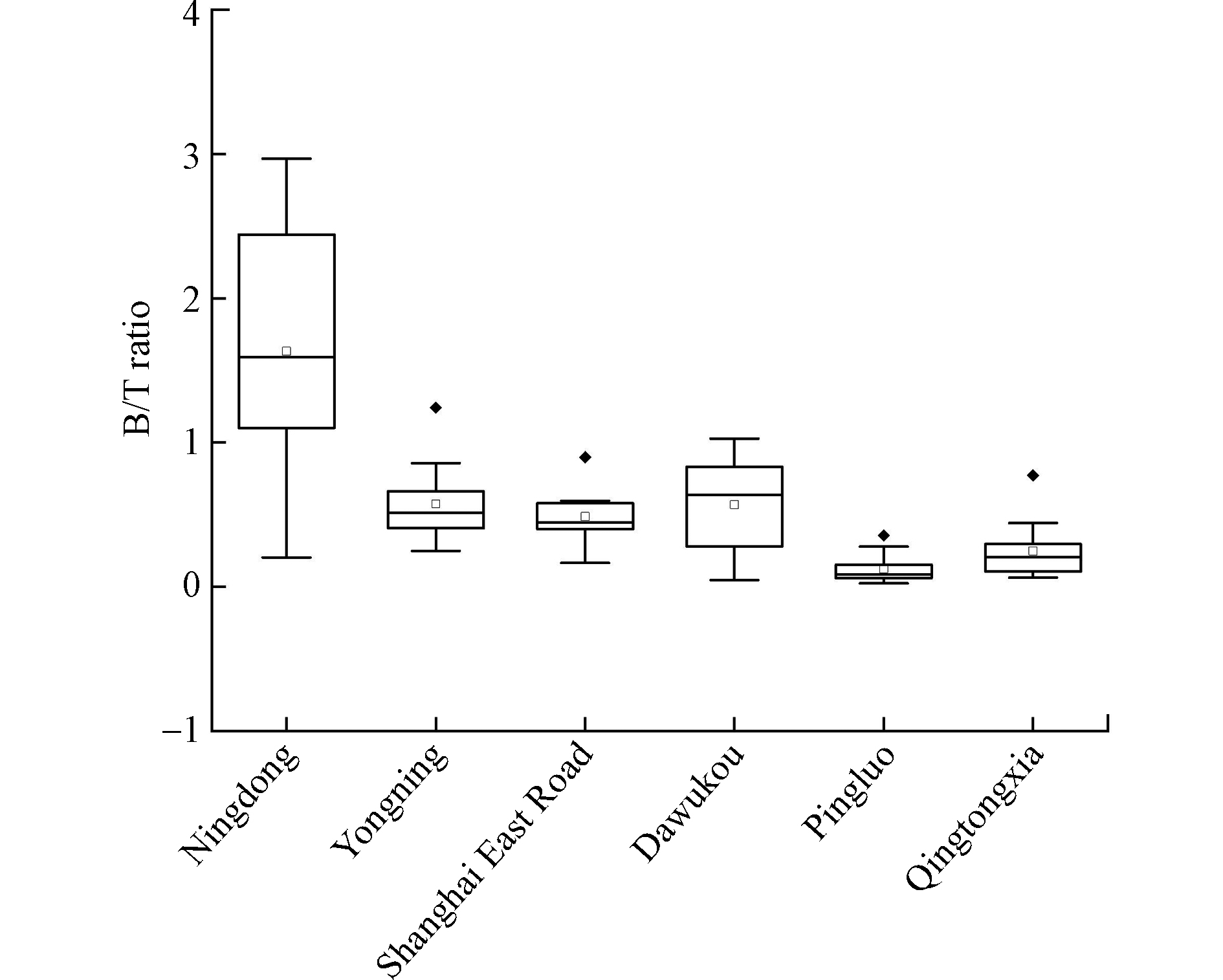 图 6 各采样点苯/甲苯比值箱线图Figure 6. Box and whisker plots of benzene/toluene ratio at each sampling site.框中实线代表中值浓度,框底部和顶部描绘了第25个(第一个四分位数)和第75个(第三个四分位数)百分位,空心点表示平均值,实心点表示异常值,晶须的末端分别对应在Q1和Q3的IQR的1.5倍之内的最低和最高数据The solid line in the box represents the median concentration. The bottom and top of the box depict the 25th (the first four Quantile) and the 75th (third quartile) percentile. The hollow dots represent the average value, and the solid dots represent the outliers. The ends of the whiskers correspond to the lowest and highest data still within 1.5 times the IQR of Q1 and Q3, respectively.
图 6 各采样点苯/甲苯比值箱线图Figure 6. Box and whisker plots of benzene/toluene ratio at each sampling site.框中实线代表中值浓度,框底部和顶部描绘了第25个(第一个四分位数)和第75个(第三个四分位数)百分位,空心点表示平均值,实心点表示异常值,晶须的末端分别对应在Q1和Q3的IQR的1.5倍之内的最低和最高数据The solid line in the box represents the median concentration. The bottom and top of the box depict the 25th (the first four Quantile) and the 75th (third quartile) percentile. The hollow dots represent the average value, and the solid dots represent the outliers. The ends of the whiskers correspond to the lowest and highest data still within 1.5 times the IQR of Q1 and Q3, respectively.一些VOCs组分虽然来源相似,但其光化学反应活性相差很大,因此,这些组分间的比值可用来反映光化学老化程度。图7为间/对-二甲苯/乙苯的散点图,结果表明,不同时间、不同采样点环境空气中间/对-二甲苯和乙苯对应浓度之间呈显著相关,说明观测期间这两种组分具有相似的来源[18-19]。间/对-二甲苯和乙苯可被·OH和·NO3氧化(白天主要与·OH反应,晚上主要与·NO3反应)[20-21]。间/对-二甲苯与·OH的反应速率大约是乙苯的3倍(间/对-二甲苯和乙苯与·OH的反应速率分别为18.90 × 10−12 cm3∙molecule−1∙s−1、7.00 × 10−12 cm3∙molecule−1∙s−1)[22-23],随着间/对-二甲苯与·OH的反应速率的增大,间/对-二甲苯和乙苯间的比值(m/p-Xylene/ Ethylbenzene,X/E)逐渐减小,X/E的值越小,·OH暴露量越大,大气中光化学反应越活跃,空气质量老化的程度就越高[24-25]。从各采样点的间/对-二甲苯/乙苯比值的箱线图来看,青铜峡采样点的平均X/E比值最小(在1.10左右),其他5个采样点平均X/E比值相当,表明青铜峡采样点的挥发性有机物与·OH自由基光的光化学反应活性相对较强烈,该采样点空气的老化程度最大,更易受老化气团控制。
2.4 臭氧生成潜势
臭氧生成潜势(ozone formation potential,OFP)常被用来衡量VOCs组分生成臭氧的能力。本研究通过最大增量反应活性法(maximum incremental reactivity,MIR)来计算VOCs组分的臭氧生成潜势,并分析VOCs各组成成分对臭氧生成的贡献[26],臭氧生成潜势的计算公式:
OFPi=VOCsi×MIRi 式中,OFPi为VOCs组分i的臭氧生成潜势,
× × 图8显示了各采样点在观测期间不同类别挥发性有机物对臭氧生成潜势的贡献,结果表明,在6个采样点中烯烃对臭氧生成潜势都有较大贡献(23.20%—85.26%),其中,宁东采样点中烯烃对OFP的贡献率是6个采样点中最大,高达85.26%,这是由该采样点烯烃的高浓度及烯烃的高光化学反应活性共同导致的。与VOCs组成分析结果对比可知,不同VOCs组成的浓度占比与其对应的OFP贡献率之间存在一定关系。烯烃是主要的活性烃,在光照条件下能够产生大量自由基,从而对O3的生成产生重要贡献,从本研究结果看,烯烃对臭氧生成潜势的贡献情况与其浓度占比情况不一致,永宁、上海东路、大武口、平罗和青铜峡采样点中烯烃虽浓度占比不高,但其臭氧生成潜势贡献却十分明显,这主要与烯烃的高光化学反应活性有关。此外,在6个采样点中,短链烷烃的浓度占比高于长链烷烃,但短链烷烃对OFP的贡献率却低于长链烷烃,这与长链烷烃是活性烃,短链烷烃是低反应性烃有关。这些结果均表明VOCs组分的光化学反应活性在臭氧生成过程中起重要作用。
本研究中OFP贡献前10位的VOCs组分主要是烯烃和烷烃(图9),进一步与各采样点浓度最大的前10位VOCs组分(图5)比对可知,浓度较低的1-丁烯、顺式-2-丁烯、反式-2-丁烯等烯烃组分的对OFP的贡献反而较大,但不同采样点之间存在一定差异。
同处于工业区的宁东和永宁采样点,由于工业排放源种类以及污染物排放强度不同,对OFP贡献的主要VOCs组分也有所不同,宁东采样点中主要OFP贡献组分是丙烯(3.15
× × × × × × × × × × × × × × × × × 2.5 二次有机气溶胶生成潜势
为进一步了解环境空气中VOCs对银川都市圈地区二次有机气溶胶生成的影响,本研究采用气溶胶生成系数法(FAC法)估算观测期间各采样点的二次有机气溶胶生成潜势(SOAP),公式如下:
SOAP=VOCsi×FACi1−FVOCsi 式中,SOAP指SOA的生成潜势(μg·m−3);VOCsi指VOCs中i组分的浓度(μg·m−3);FACi指i组分的SOA的生成系数(%),FVOCsi为i组分参与氧化反应的份额(%)[27-28]。
宁东、永宁、上海东路、大武口、平罗、青铜峡采样点SOAP均值分别为86.02、29.25、206.43、55.27、59.45、46.33 μg·m−3。6个采样点SOAP组成相似(图10),其中,芳香烃浓度占比最大(宁东79.41%、永宁70.05%、上海东路82.40%、大武口67.67%、平罗89.52%、青铜峡61.49%),而烷烃和烯烃的贡献相对较小。图11展示了各采样点对SOAP贡献前10的VOCs组分,结果表明,各采样点VOCs中对SOAP贡献较大的组分十分相似,均以芳香烃类居多,间/对-二甲苯、甲苯、间-乙基甲苯、对-二乙基苯对各采样点的SOAP中均有较大贡献,尤其在上海东路采样点中甲苯(3.85
× × × 3. 结论(Conclusion)
在银川都市圈工业区、商业/交通/居民混合区和工业/交通混合区中,尽管各采样点环境空气中VOCs的组分浓度及反应活性有所差异,但都以烯烃和长链烷烃组分为主;短链烷烃和长链烷烃在各点位都有较高的浓度占比,分别为30.85%—45.21%、15.17%—48.79%,这可能与机动车尾气排放有关。烯烃在宁东煤化工区采样点的浓度占比(43.77%)最为显著,炔烃、芳香烃在平罗采样点的浓度占比最高,分别为29.98%和14.00%,这可能与这些采样点的VOCs来源差异有关。宁东煤化工区采样点的VOCs总浓度水平高于其他5个采样点。尽管烯烃的浓度占比不高,但其生成臭氧的潜力较大,烯烃对臭氧生成潜势的贡献在23.2%—85.26%。6个采样点中各VOCs组成对SOAP的贡献相似,其中,芳香烃的贡献最大,贡献率在61.49%—89.52%。因此,O3污染和雾霾污染问题的改善需同时考虑VOCs组分浓度及其光化学反应活性。
-
表 1 采样点信息汇总
Table 1. Summary of sampling information
功能区Functional area 采样点Sampling points 经纬度Latitude and longitude 样本量Sample size 工业区Industrial areas 宁东 106.62 °E,38.20 °N 12 永宁 106.26 °E,38.37 °N 12 商业/交通/居民混合区Commercial, traffic, and residential mixed areas 上海东路 106.29 °E,38.50 °N 12 大武口 106.38 °E,39.01 °N 12 工业/交通混合区Industrial and traffic mixed areas 平罗 106.50 °E,38.96 °N 12 青铜峡 105.89 °E,37.91 °N 12 表 2 观测期间各采样点气象条件
Table 2. Meteorological conditions at each sampling point during the observation period
采样点Sampling points 项目Project 2019年6月 2019年8月 最小值Minimum value 最大值Maximum value 平均值Average value 最小值Minimum value 最大值Maximum value 平均值Average value 宁东Ningdong 温度/℃ 19 31 26.5 19 32 27.17 相对湿度/% 24 70 40 33 67 44.5 主导风向 东南风 西北风 永宁Yongning 温度/℃ 19 33 27.67 — — — 相对湿度/% 26 81 44.33 — — — 主导风向 东南风 西北风 上海东路Shanghai East Road 温度/℃ 26 32 28.67 25 34 29.5 相对湿度/% 16 42 30.83 18 59 34 主导风向 东南风 西北风 大武口Dawukou 温度/℃ 20 25 22.33 — — — 相对湿度/% 17 33 25.5 — — — 主导风向 西北风 西北风 平罗Pingluo 温度/℃ 18 31 26.83 23 31 28.83 相对湿度/% 28 80 44.33 31 69 46.83 主导风向 西北转北风 西北风 青铜峡Qingtongxia 温度/℃ 22 32 27 21 33 29.5 相对湿度/% 32 62 42.67 21 64 37.5 主导风向 西北转北风 西北风 注:“—”代表数据缺失.means data is missing. -
[1] ATKINSON R. Atmospheric chemistry of VOCs and NOx [J]. Atmospheric Environment, 2000, 34(12/14): 2063-2101. [2] ATKINSON R, AREY J. Atmospheric degradation of volatile organic compounds [J]. Chemical Reviews, 2003, 103(12): 4605-4638. doi: 10.1021/cr0206420 [3] 中华人民共和国生态环境部. 中国生态环境状况公报[R]. 2015—2019. Ministry of Ecology and Environment of the People’s Republic of China. Bulletin on the State of China’s Ecological Environment[R]. 2015—2019(in Chinese).
[4] LIU Y, SHAO M, FU L L, et al. Source profiles of volatile organic compounds (VOCs) measured in China: Part I [J]. Atmospheric Environment, 2008, 42(25): 6247-6260. doi: 10.1016/j.atmosenv.2008.01.070 [5] 宁夏回族自治区生态环境厅. 宁夏生态环境状况公报[R]. 2015—2019. Department of Ecological Environment of Ningxia Hui Autonomous Region. Bulletin of Ningxia Ecological Environment[R]. 2015—2019(in Chinese).
[6] USEPA. Compendium method TO-14A: Determination of volatile organic compounds (VOCs) in ambient air using specially prepared canisters with subsequent analysis by gas chromatography[S]. 1999. [7] USEPA. Compendium method TO-15: Determination of volatile organic compounds (VOCs) in air collected in specially-prepared canisters and analyzed by gas chromatography/mass spectrometry (GC/MS)[S]. 1999. [8] 马伟, 王章玮, 郭佳, 等. 一个沿海城市大气臭氧的本地生成过程及其对前体物的敏感性 [J]. 环境科学学报, 2019, 39(11): 3593-3599. MA W, WANG Z W, GUO J, et al. Sensitivity of ambit atmospheric ozone to precoursor species and locate fort sociation [J]. Acta Scientiae Circumstantiae, 2019, 39(11): 3593-3599(in Chinese).
[9] 黄海梅, 郭佳, 王章玮, 等. 贵阳市大气挥发性有机物的初步分析 [J]. 环境化学, 2018, 37(11): 2387-2396. doi: 10.7524/j.issn.0254-6108.2018012301 HUANG H M, GUO J, WANG Z W, et al. Preliminary analysis of ambient volatile organic compounds in Guiyang, China [J]. Environmental Chemistry, 2018, 37(11): 2387-2396(in Chinese). doi: 10.7524/j.issn.0254-6108.2018012301
[10] ZHANG J, WANG T, CHAMEIDES W L, et al. Ozone production and hydrocarbon reactivity in Hong Kong, Southern China [J]. Atmospheric Chemistry and Physics, 2007, 7(73): 557-573. [11] 付琳琳, 邵敏, 刘源, 等. 机动车VOCs排放特征和排放因子的隧道测试研究 [J]. 环境科学学报, 2005, 25(7): 879-885. doi: 10.3321/j.issn:0253-2468.2005.07.004 FU L L, SHAO M, LIU Y, et al. Tunnel experimental study on the emission factors of volatile organic compounds (VOCs)from vehicles [J]. Acta Scientiae Circumstantiae, 2005, 25(7): 879-885(in Chinese). doi: 10.3321/j.issn:0253-2468.2005.07.004
[12] 乔月珍, 王红丽, 黄成, 等. 机动车尾气排放VOCs源成分谱及其大气反应活性 [J]. 环境科学, 2012, 33(4): 1071-1079. QIAO Y Z, WANG H L, HUANG C, et al. Source profile and chemical reactivity of volatile organic compounds from vehicle exhaust [J]. Environmental Science, 2012, 33(4): 1071-1079(in Chinese).
[13] 鲁君, 王红丽, 陈长虹, 等. 上海市机动车尾气VOCs组成及其化学反应活性 [J]. 环境污染与防治, 2010, 32(6): 32-39. doi: 10.3969/j.issn.1001-3865.2010.06.008 LU J, WANG H L, CHEN C H, et al. The composition and chemical reactivity of volatile organic compounds (VOCs) from vehicle exhaust in Shanghai, China [J]. Environmental Pollution & Control, 2010, 32(6): 32-39(in Chinese). doi: 10.3969/j.issn.1001-3865.2010.06.008
[14] HO K F, LEE S C, HO W K, et al. Vehicular emission of volatile organic compounds (VOCs) from a tunnel study in Hong Kong [J]. Atmospheric Chemistry and Physics, 2009, 9(19): 7491-7504. doi: 10.5194/acp-9-7491-2009 [15] BROCCO D, FRATARCANGELI R, LEPORE L, et al. Determination of aromatic hydrocarbons in urban air of Rome [J]. Atmospheric Environment, 1997, 31(4): 557-566. doi: 10.1016/S1352-2310(96)00226-9 [16] CELESTE YaraMoreira dos Santos,DÉBORADE Almeida Azevedo,FRANCISCO Radlerde Aquino Neto. Atmospheric distribution of organic compounds from urban areas near a coal-fired power station [J]. Atmospheric Environment, 2004, 38(9): 1247-1257. doi: 10.1016/j.atmosenv.2003.11.026 [17] BARLETTA B, MEINARDI S, ROWLAND F S, et al. Volatile organic compounds in 43 Chinese cities [J]. Atmospheric Environment, 2005, 39(32): 5979-5990. doi: 10.1016/j.atmosenv.2005.06.029 [18] LIU Y F, SONG M D, LIU X G, et al. Characterization and sources of volatile organic compounds (VOCs) and their related changes during ozone pollution days in 2016 in Beijing, China [J]. Environmental Pollution, 2020, 257(2020): 113-125. [19] JIANG Z H, ZHENG X, ZHAI H Q, et al. Seasonal and diurnal characteristics of carbonyls in the urban atmosphere of Changsha, a mountainous city in south-central China [J]. Environmental Pollution, 2019, 253: 259-267. [20] CARTER W P L. A detailed mechanism for the gas-phase atmospheric reactions of organic compounds [J]. Atmospheric Environment, 2007, 41: 80-117. [21] NING X Z, XIN H, WEI N, et al. Influence of synoptic condition and holiday effects on VOCs and ozone production in the Yangtze River Delta region, China [J]. Atmospheric Environment, 2017, 168: 112-124. [22] CARTER W P L. Development of the SAPRC-07 chemical mechanism [J]. Atmospheric Environment, 2010, 44(40): 5324-5335. doi: 10.1016/j.atmosenv.2010.01.026 [23] AN J L, WANG Y S, WU F K, et al. Characterizations of volatile organic compounds during high ozone episodes in Beijing, China [J]. Environmental Monitoring and Assessment, 2012, 184(4): 1879-1889. doi: 10.1007/s10661-011-2086-7 [24] HUANG C, WANG H L, LI L, et al. VOC species and emission inventory from vehicles and their SOA formation potentials estimation in Shanghai, China [J]. Atmospheric Chemistry and Physics, 2015, 15(19): 11081-11096. doi: 10.5194/acp-15-11081-2015 [25] HAN T T, MA Z Q, XU W Y, et al. Characteristics and source implications of aromatic hydrocarbons at urban and background areas in Beijing, China [J]. Science of the Total Environment, 2020, 707: 136-148. [26] 张利慧, 毋振海, 李斌, 等. 北京市城区春季大气挥发性有机物污染特征 [J]. 环境科学研究, 2020, 33(3): 526-535. ZHANG L H, WU Z H, LI B, et al. Pollution characterizations of atmospheric volatile organic compounds in spring of Beijing urban area [J]. Research of Environmental Sciences, 2020, 33(3): 526-535(in Chinese).
[27] GROSJEAN D, SEINFELD J H. Parameterization of the formation potential of secondary organic aerosols [J]. Atmospheric Environment, 1989, 23(8): 1733-1747. doi: 10.1016/0004-6981(89)90058-9 [28] GROSJEAN D. In situ organic aerosol formation during a smog episode: Estimated production and chemical functionality [J]. Atmospheric Environment. Part A. General Topics, 1992, 26(6): 953-963. doi: 10.1016/0960-1686(92)90027-I -




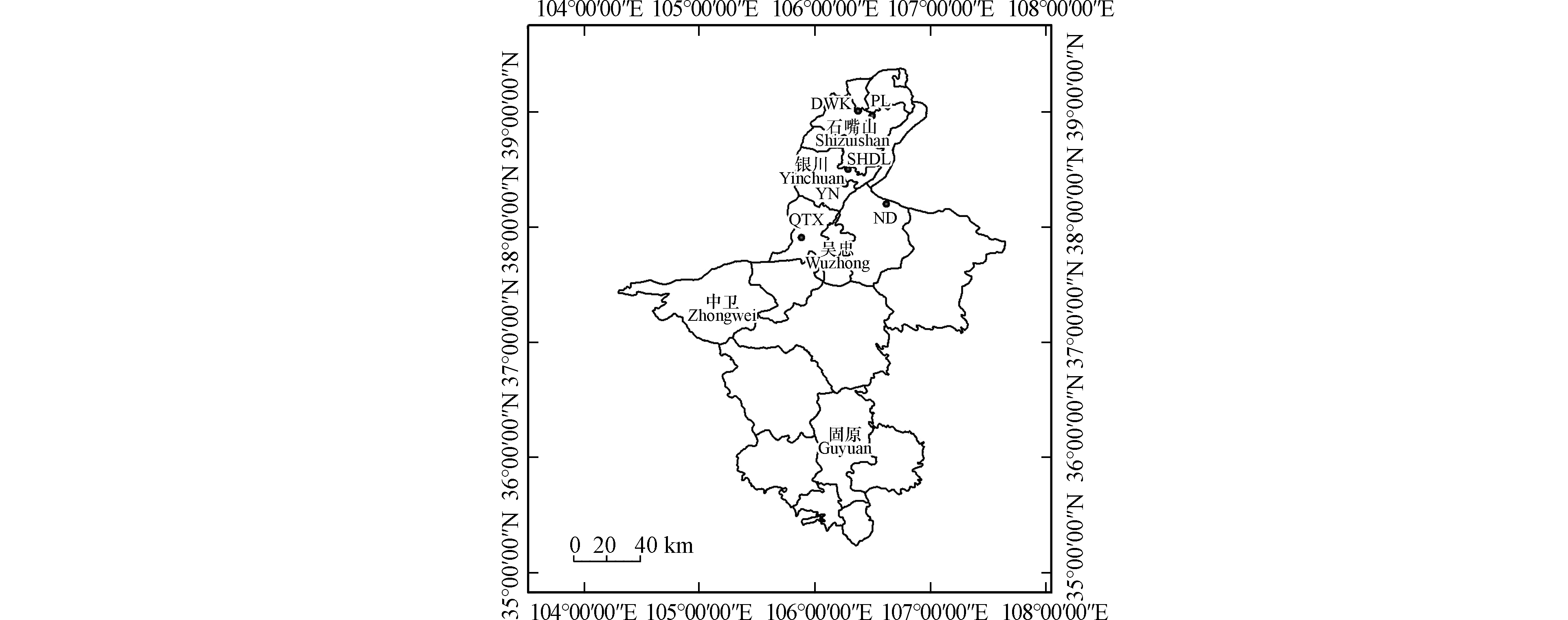
 下载:
下载:


